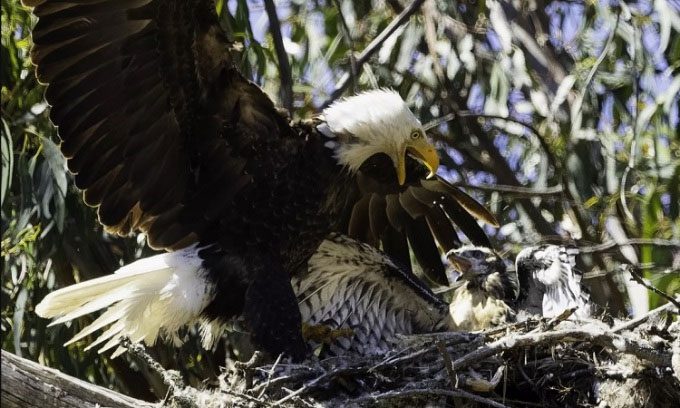Tuffy, the young red-tailed hawk stolen by a bald eagle from its nest on May 20, is now living with the family of its captor in the Bay Area woods.
The adoptive parents brought food for Tuffy and their biological chick Lona. Tuffy is growing rapidly; over the past week, it has successfully flown several times, according to the Los Angeles Times. This incident has surprised birdwatchers, as bald eagles and red-tailed hawks are considered “eternal” foes. Such behavior is extremely rare and has only been recorded four times in the wild.

Young red-tailed hawk growing up in a bald eagle’s nest. (Photo: Doug Gillard).
Six weeks ago, Doug Gillard, a professor of surgery and physiology at Life Chiropractic College West in Hayward, photographed the eagle family. He discovered the bird’s nest last year and returned in January to observe the eagles mating, nesting in a eucalyptus tree, incubating eggs, foraging, and caring for their new chick named Lona.
Bald eagles were removed from the endangered species list in the U.S. in 2017 but remain threatened in California. They have a wingspan of 8 feet and weigh between 8 to 14 pounds. The red-tailed hawk is smaller and more abundant, with a wingspan of only half that of the eagle and weighing about 2.2 pounds. Images of Tuffy and Lona taken through binoculars clearly show the size difference between the two species.
Gillard spotted the female bald eagle dropping Tuffy into the nest on May 20. He was very surprised to see it alive the next day. A week later, a second young hawk appeared in the nest but was much smaller and disappeared overnight. Nearby ranchers informed Gillard that the male bald eagle had killed it.
No one knows for sure what is happening, but some experts suggest that the female bald eagle may have captured the young red-tailed hawk while searching for food for its own chick. After placing the hawk in the nest and hearing its calls, the female may have been confused. “I’ve read about similar adoption cases. Young hawks have been brought to the nest as prey but still survived,” shared Cheryl Dykstra, a raptor researcher and editor at the journal Raptor Research. “The parent eagles then start to feed the hawk as if it were their own.”
According to Dykstra, this behavior has also been observed in several other raptor species, including the white-tailed sea eagle adopting a tern chick. “It’s unclear whether raptors can distinguish their own young, but they often do not show aggression towards adopted chicks,” Dykstra noted.
Jordan Spyke, the director of operations and raptor rescue at the Montana Raptor Conservation Center, speculated that the eagle may not have realized the red-tailed hawk was still alive when it captured it, as hawks often flatten themselves when they see a predator, especially when they are young.



















































